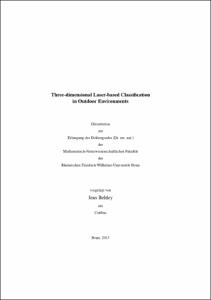Behley, Jens: Three-dimensional Laser-based Classification in Outdoor Environments. - Bonn, 2014. - Dissertation, Rheinische Friedrich-Wilhelms-Universität Bonn.
Online-Ausgabe in bonndoc: https://nbn-resolving.org/urn:nbn:de:hbz:5n-35045
Online-Ausgabe in bonndoc: https://nbn-resolving.org/urn:nbn:de:hbz:5n-35045
@phdthesis{handle:20.500.11811/6031,
urn: https://nbn-resolving.org/urn:nbn:de:hbz:5n-35045,
author = {{Jens Behley}},
title = {Three-dimensional Laser-based Classification in Outdoor Environments},
school = {Rheinische Friedrich-Wilhelms-Universität Bonn},
year = 2014,
month = feb,
note = {Robotics research strives for deploying autonomous systems in populated environments, such as inner city traffic. Autonomous cars need a reliable collision avoidance, but also an object recognition to distinguish different classes of traffic participants. For both tasks, fast three-dimensional laser range sensors generating multiple accurate laser range scans per second, each consisting of a vast number of laser points, are often employed. In this thesis, we investigate and develop classification algorithms that allow us to automatically assign semantic labels to laser scans. We mainly face two challenges: (1) we have to ensure consistent and correct classification results and (2) we must efficiently process a vast number of laser points per scan. In consideration of these challenges, we cover both stages of classification -- the feature extraction from laser range scans and the classification model that maps from the features to semantic labels.
As for the feature extraction, we contribute by thoroughly evaluating important state-of-the-art histogram descriptors. We investigate critical parameters of the descriptors and experimentally show for the first time that the classification performance can be significantly improved using a large support radius and a global reference frame.
As for learning the classification model, we contribute with new algorithms that improve the classification efficiency and accuracy. Our first approach aims at deriving a consistent point-wise interpretation of the whole laser range scan. By combining efficient similarity-preserving hashing and multiple linear classifiers, we considerably improve the consistency of label assignments, requiring only minimal computational overhead compared to a single linear classifier.
In the last part of the thesis, we aim at classifying objects represented by segments. We propose a novel hierarchical segmentation approach comprising multiple stages and a novel mixture classification model of multiple bag-of-words vocabularies. We demonstrate superior performance of both approaches compared to their single component counterparts using challenging real world datasets.},
url = {https://hdl.handle.net/20.500.11811/6031}
}
urn: https://nbn-resolving.org/urn:nbn:de:hbz:5n-35045,
author = {{Jens Behley}},
title = {Three-dimensional Laser-based Classification in Outdoor Environments},
school = {Rheinische Friedrich-Wilhelms-Universität Bonn},
year = 2014,
month = feb,
note = {Robotics research strives for deploying autonomous systems in populated environments, such as inner city traffic. Autonomous cars need a reliable collision avoidance, but also an object recognition to distinguish different classes of traffic participants. For both tasks, fast three-dimensional laser range sensors generating multiple accurate laser range scans per second, each consisting of a vast number of laser points, are often employed. In this thesis, we investigate and develop classification algorithms that allow us to automatically assign semantic labels to laser scans. We mainly face two challenges: (1) we have to ensure consistent and correct classification results and (2) we must efficiently process a vast number of laser points per scan. In consideration of these challenges, we cover both stages of classification -- the feature extraction from laser range scans and the classification model that maps from the features to semantic labels.
As for the feature extraction, we contribute by thoroughly evaluating important state-of-the-art histogram descriptors. We investigate critical parameters of the descriptors and experimentally show for the first time that the classification performance can be significantly improved using a large support radius and a global reference frame.
As for learning the classification model, we contribute with new algorithms that improve the classification efficiency and accuracy. Our first approach aims at deriving a consistent point-wise interpretation of the whole laser range scan. By combining efficient similarity-preserving hashing and multiple linear classifiers, we considerably improve the consistency of label assignments, requiring only minimal computational overhead compared to a single linear classifier.
In the last part of the thesis, we aim at classifying objects represented by segments. We propose a novel hierarchical segmentation approach comprising multiple stages and a novel mixture classification model of multiple bag-of-words vocabularies. We demonstrate superior performance of both approaches compared to their single component counterparts using challenging real world datasets.},
url = {https://hdl.handle.net/20.500.11811/6031}
}






